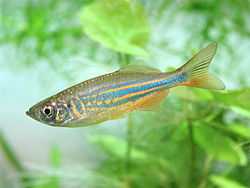Devario
| Devario | |
|---|---|
 | |
| Giant danio, Devario aequipinnatus | |
| Scientific classification | |
| Kingdom: | Animalia |
| Phylum: | Chordata |
| Class: | Actinopterygii |
| Order: | Cypriniformes |
| Family: | Cyprinidae |
| Subfamily: | Danioninae |
| Genus: | Devario Heckel, 1843 |
| Type species | |
| Cyprinus devario F. Hamilton, 1822 | |
| Species | |
|
See text | |
| Synonyms | |
The genus Devario comprises some danionins familiar to aquarists. Generally, they are larger fish than species of the genus Danio, they have short barbels (if present at all), and generally have deeper bodies than Danio species, with species having vertical or horizontal stripes present. In size, they range from 5 to 15 cm (2 to 6 in).
Taxonomy
Many species that were formerly within the Danio genus, such as the giant danio, have now been reclassified as Devario.[1] In addition, Devario acuticephala, Devario shanensis and Devario sondhii were also regarded at one time as being in the now junior synonym genus Brachydanio.
The Khanka spiny bitterling (Acanthorhodeus chankaensis) and the Russian bitterling (Acheilognathus asmussii) were previously classified as Devario, but now are placed in a completely different subfamily, the Acheilognathinae (bitterlings).
Species
The 38 currently recognized species in this genus are:[2]
- Devario acrostomus (F. Fang & Kottelat, 1999)
- Devario acuticephala (Hora, 1921)
- Devario aequipinnatus (McClelland, 1839) (giant danio)
- Devario affinis (Blyth, 1860)
- Devario annandalei (B. L. Chaudhuri, 1908)
- Devario anomalus Conway, Mayden & K. L. Tang, 2009
- Devario apogon (X. L. Chu, 1981)
- Devario apopyris (F. Fang & Kottelat, 1999)
- Devario assamensis (Barman, 1984)
- Devario auropurpureus (Annandale, 1918)
- Devario browni (Regan, 1907)
- Devario chrysotaeniatus (X. L. Chu, 1981)
- Devario devario (F. Hamilton, 1822) (Sind danio)
- Devario fangfangae (Kottelat, 2000)
- Devario fraseri (Hora, 1935)
- Devario gibber (Kottelat, 2000)
- Devario horai (Barman, 1983)
- Devario interruptus (F. Day, 1870)
- Devario kakhienensis (J. Anderson, 1879)
- Devario laoensis (Pellegrin & P. W. Fang, 1940)
- Devario leptos (F. Fang & Kottelat, 1999)
- Devario maetaengensis (F. Fang, 1997)
- Devario malabaricus (Jerdon, 1849) (Malabar danio)
- Devario manipurensis (Barman, 1987)
- Devario naganensis (B. L. Chaudhuri, 1912)
- Devario neilgherriensis (F. Day, 1867)
- Devario ostreographus (McClelland, 1839)
- Devario pathirana (Kottelat & Pethiyagoda, 1990) (barred danio)
- Devario peninsulae (H. M. Smith, 1945)
- Devario regina (Fowler, 1934)
- Devario salmonata (Kottelat, 2000)
- Devario shanensis (Hora, 1928) (Hora danio)
- Devario sondhii (Hora & Mukerji, 1934)
- Devario spinosus (F. Day, 1870)
- Devario strigillifer (G. S. Myers, 1924)
- Devario suvatti (Fowler, 1939)
- Devario xyrops F. Fang & S. O. Kullander, 2009
- Devario yuensis (Arunkumar & Tombi Singh, 1998)
Devario sp. "giraffe" is an as yet undescribed species.
Characteristics
They are native to the freshwater rivers and streams of Southeast Asia, but many species are brightly coloured, and are available as aquarium fish worldwide. A number of the species, only recently discovered in remote inland areas of Laos and Myanmar, do not yet have scientific names.
They generally do not live for more than about two to three years, and are probably annual fish in the wild, although the larger species may live for up to five years.
In the wild, these fish consume various small, aquatic insects, crustaceans, and worms, as well as, in the case of fry, plankton.
In the aquarium
The care of members of the genus Devario are rather similar and easily generalized. They are generally easy to moderate in keeping difficulty.
All of these fish are primarily surface feeders. They are omnivorous in the aquarium and will accept a wide variety of foods; flake food is appropriate. Living in aquaria, live/frozen flaked foods are suitable, especially brine shrimp and sinking tablets. Conditioning danios for breeding should include plenty of fresh foods.
Although boisterous and liable to chase each other and other fish, they are good community fish and will not generally attack each other or other fish, although they occasionally nip fins, more by accident than design; like most fish, they will eat eggs and any fish small enough to fit into their mouths, in the case of the larger devarios, this could include fish, such as small tetras.
They are best kept in a tank long enough for their active swimming, preferably with a current from a power filter (or at least airstone), as they often live in fast-flowing streams in the wild. Generally, this also results in them being subtropical with cooler temperatures. They are good jumpers, so a tight-fitting lid is recommended.
As schooling fish, they prefer to be in groups of six or more. Devario species prefer water with a pH of 6 to 8, a hardness no more than 19 dGH, and a temperature range of 68–80°F (18–24°C), the lower end of the temperature range is ideal.
Breeding
Some species of Devario, such as the giant danio, are among the easiest aquarium fish to breed. Other species, such as Devario pathirana, are far harder to spawn. All scatter their eggs over the substrate. The eggs are adhesive and hatch within 2–3 days. Eggs will be eaten enthusiastically unless protected by a heavy planting, e.g. Java moss, or a spawning mop.
External links
- "Danios and Devarios". Danios and devarios website. Retrieved 2005-10-01.
- "Clarke, Matt (2005) - A fishkeeper's guide to danios and devarios.". Article on danionins at Practical Fishkeeping's website. Archived from the original on 2005-12-24. Retrieved 2005-10-01.
See also
References
- ↑ Fang, Fang; Douglas, M. E. (2003). "Phylogenetic Analysis of the Asian Cyprinid Genus Danio (Teleostei, Cyprinidae)". In Douglas, M. E. Copeia 2003 (4): 714–728. doi:10.1643/IA03-131.1.
- ↑ Froese, Rainer, and Daniel Pauly, eds. (2012). Species of Devario in FishBase. October 2012 version.